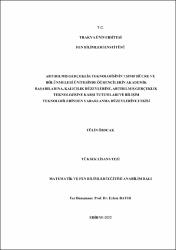Artırılmış gerçeklik teknolojisinin 7. sınıf hücre ve bölünmeleri ünitesinde öğrencilerin akademik başarılarına, kalıcılık düzeylerine, artırılmış gerçeklik teknolojisine karşı tutumları ve bilişim teknolojilerinden yararlanma düzeylerine etkisi
Abstract
Bu çalışma fen bilimleri dersi ‘‘Hücre ve Bölünmeleri’’ ünitesinde artırılmış
gerçeklik teknolojisinin kullanılmasının 7. sınıf öğrencilerinin akademik başarılarına,
teknolojiye karşı tutumlarına, kalıcılık düzeylerine ve artırılmış gerçekliğe karşı
tutumlarına etkisini incelenmesi amacıyla gerçekleştirilmiştir. Çalışma 2019-2020 eğitim
öğretim yılı içerisinde, Edirne merkeze bağlı bir ortaokulda toplam 42 öğrenci ile
yürütülmüştür. Çalışmada nicel yöntem olarak öntest ve sontest kontrol gruplu seçkisiz
yarı deneysel desen kullanılırken nitel yöntem olarak ise durum çalışması kullanılmıştır .
Bu doğrultuda, ders planları hazırlanarak haftada 4 saat toplam 4 hafta boyunca
uygulanmıştır. Deney grubu öğrencileri için artırılmış gerçeklik uygulamalarını içeren ve
5E öğretim modeline dayanan ders planları, kontrol grubu öğrencilerine ise 5E modeline
dayanan ders planları hazırlanmıştır. Çalışmada veri toplama aracı olarak, her iki gruba
da ‘‘Hücre ve Bölünmeleri’’ Ünitesi Başarı Testi, Bilişim Teknolojilerinden Yararlanma
Ölçeği öntest sontest olarak uygulanmıştır. Ayrıca Artırılmış Gerçeklik Tutum Ölçeği
sadece deney grubu öğrencilerine öntest ve sontest olarak uygulanmıştır. Artırılmış
gerçeklik teknoloji ile yapılan çalışma bulgularına göre, deney grubu ve kontrol grubu
öğrencilerinin akademik başarı puanlarında anlamlı bir fark olmadığı görülürken bilişim
teknolojilerinden yararlanma düzeylerinde ve kalıcılık düzeylerinde deney grubunun
lehine anlamlı bir fark olduğu görülmüştür. Deney grubu öğrencilerine uygulanan
artırılmış gerçeklik tutum ölçeği analizlerinde öğrencilerin öntest ve sontest puanlarında
anlamlı bir fark olduğu sonucuna ulaşılmıştır. Deney grubu öğrencilerinin cevaplarından
elde edilen nitel veriler incelendiğinde ise öğrencilerin dersi daha iyi anlama, derslerin
eğlenceli olması, üç boyutlu gözlem yapılabilmesi gibi nedenler ile artırılmış gerçekliği
Fen Bilimleri dersinde birçok konuda ve çeşitli branşlarda her zaman kullanmak
istediklerine ve bunda en önemli etkinin gözlenmesi zor konuların olduğu sonucuna
varılmıştır. This study was carried out to examine the effects of using augmented reality
technology in the "Cell and Its Divisions" unit of science course on 7th grade students'
academic achievement, attitudes towards technology, permanence levels and attitudes
towards augmented reality. The study was carried out with a total of 42 students in a
secondary school in the center of Edirne in the 2019-2020 academic year. In the study, a
random quasi-experimental design with pretest and posttest control groups was used as a
quantitative method, while a case study was used as a qualitative method. In this direction,
lesson plans were prepared and applied 4 hours a week for a total of 4 weeks. Lesson
plans including augmented reality applications and based on the 5E teaching model were
prepared for the experimental group students, and lesson plans based on the 5E model
were prepared for the control group students. As a data collection tool in the study, the
"Cell and Its Divisions" Unit Achievement Test and the Information Technologies
Utilization Scale were applied as pretest and posttest to both groups. In addition, the
Augmented Reality Attitude Scale was applied only to the experimental group students
as pretest and posttest. According to the findings of the study conducted with augmented
reality technology, it was seen that there was no significant difference in the academic
achievement scores of the experimental group and control group students while It has
been observed that there is a significant difference in favor of the experimental group in
the levels of benefiting from information technologies and their permanence levels. In the
augmented reality attitude scale analyzes applied to the experimental group students, it
was concluded that there was a significant difference in the pretest and posttest scores of
the students. When the qulitative data obtained from the answers of the experimental
group students are examined, ıt has been concluded that the students always want to use
augmented reality in many subjects and various branches in the Science course due to
reasons such as better understanding of the lesson, the fun of the lessons, and the ability
to observe three-dimensionally, and the most important effect on this is the subjects that
are difficult to observe.
Collections
- Tez Koleksiyonu [1287]


















